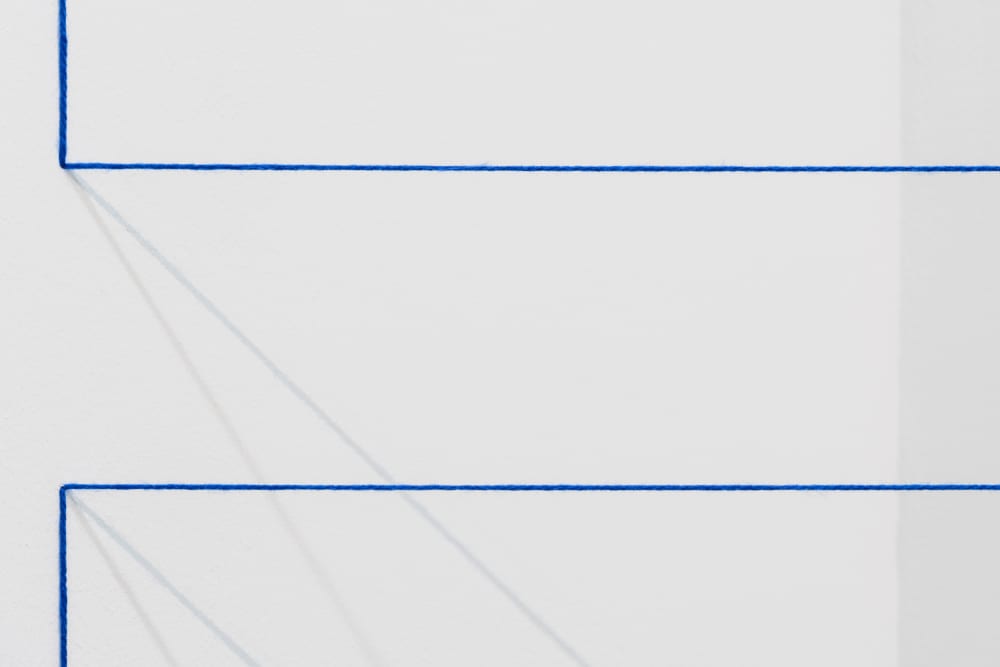FRED SANDBACK
-
介绍
Each encounter with Fred Sandback’s sculpture is unique. The works may appear easily overlooked, especially when approached from afar, on account of their slight materiality: acrylic yarn lines stretched between wall, ceiling, or floor. But, if we look closer, the lines themselves form bodies, outlines of planes or volumes, simultaneously occupying space and yet leaving so much room. How does that work?
Beginning during his studies at Yale School of Art and Architecture in the 1960s, Sandback’s works were originally made of steel wire and elastic cord (it was only after the early 1970s that commercial acrylic yarn became his signature material). In 1968, while still a student at Yale, Sandback had his first solo exhibitions at Galerie Konrad Fischer, Düsseldorf, and Galerie Heiner Friedrich, Munich. Around that time, Sandback coined the term “pedestrian space” as a means of grounding and localizing his works. The artist wished his art to be in the same space as the viewers, where they move, and not isolated on a pedestal. Thus, his artwork exists within the self-same space, the living space, in which we encounter it and engage with it. Situated within the art movements of the late 1960s, the notion of “pedestrian space” thus references and makes visible a core principle: the union of art and everyday life.
Sandback spoke of his works as sculptures, but sculptures without volume, bodies without mass. “The volumes defined by these cord and string constructions form the essential elements of the works; the media could be said to be air.”[1] Yet Sandback’s work is a continuum, the core of which was formulated in his earliest works. His ideas do not lessen, become simpler, or more reduced; they don’t take on different directions, but they follow from and complement each other.
His early sculptures of the 1960s manifest as closed geometric forms. His first mature sculpture, Untitled (Red Floor Piece), 1967, is only 4 centimeters high and 11 centimeters wide, but is almost 7 meters long, formed as a rectilinear “solid” akin to a length of lumber. Later works assumed familiar geometric forms such as leaning trapezoids, or cuboids freestanding or mounted on walls.
Soon after, Sandback began to explore the line and its variable possibilities within a space by liberating it from its framing function. The open U-shape entered his repertoire, as did vertical lines running from ceiling to floor, others connect two walls across a corner.
The artist’s near-contemporaries Sol LeWitt, Donald Judd, and Carl Andre often employed simple mathematical progressions in their works, Platonic or Cartesian modes, but Sandback very soon moved away from such dictates, emerging intuitively, adapting to site and spectator. His art does not dominate a space or compete with it, but rather appears in it, in simultaneous coexistence. At other times, works appear to continue beyond a space, as if breaking through the architectural envelope. There is no front or behind to these sculptures, we can move around and through them, and yet something sculptural emerges: a void takes shape. “A piece made with just a few lines at first seems very purist and geometrical. My work isn’t either of these things,” Sandback said.[2] Depending on its situation, each work may vary in its dimensions, adapting through its interaction with the space and with the spectator’s viewpoint. Necessarily, Sandback’s works create specific situations that are however mutable, experienced in both place and time.
Sandback once described his three-dimensional work as “a drawing that is habitable.”[3] In so doing, he focused on two essential aspects inherent in his work: time and movement. Sandback’s sculptures only exist at a particular time, in the context of their installation. When dismantled, what remains is an idea; what remains for the viewer is the memory of a profound actuality.
—Text by Leonie Pfennig
[1] Press release for Fred Sandback: Five Situations; Eight Separate Pieces, Dwan Gallery, New York, January 4–29, 1969; quoted in Vazquez, Edward A. “Fred Sandback’s Perspectives,” Art Journal 71, no. 3 (2014), pp. 98–116.[2] Sandback, untitled statement first published in Plan & Space, Gent: Koninklijke Academie, 1977; available online at: https://www.fredsandbackarchive.org/texts-1977-statement.
[3] Sandback, untitled statement first published in Here and Now: Fred Sandback, Leeds: Henry Moore Institute, 1999; available online at: https://www.fredsandbackarchive.org/texts-1999-statement.
-
作品
-
安装图示
-
Inquire about works by FRED SANDBACK

-
参展艺术家








